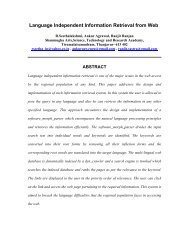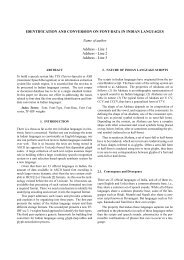Create successful ePaper yourself
Turn your PDF publications into a flip-book with our unique Google optimized e-Paper software.
Verses, Translation and Commentary 183<br />
the clarifying influences of material nature, influences from which he took<br />
assistance all along.<br />
In advanced yoga, or kriyā yoga, one has to maintain the distinction between<br />
oneself and the perceiving instruments of the subtle body, even through<br />
initially one must take help from those truth-yielding perceptions.<br />
Adhiṣṭhātṛtvaṁ means complete or full disaffection from the subtle influence<br />
of material nature, even from the clarifying powers which are so helpful.<br />
Verse 51<br />
tÖEraGyadip dae;vIj]ye kEvLym!<br />
tadvairāgyāt api doṣabījakṣaye kaivalyam<br />
tadvairāgyāt = tad (tat) – that + vairāgyāt – from a lack of interest; api –<br />
also, even; doṣabījakṣaye = doṣa – fault, defect + bīja – seed, origin,<br />
source + kṣaye – on elimination; kaivalyam – the absolute isolation of the<br />
self from what is lower than itself, isolation of the self from the lower<br />
psyche of itself.<br />
By a lack of interest, even to that<br />
(discrimination between the clarifying mundane energy<br />
and the self) when the cause of that defect is eliminated,<br />
the absolute isolation of the self from the lower psyche of itself,<br />
is achieved.<br />
Commentary:<br />
Kaivalyam, which is a popular word in yoga and meditation circles, is greatly<br />
mistranslated and misinterpreted. Its meaning is not that the yogi would<br />
become one with God. For Patañjali, the master of yoga, never says that in<br />
these verses. Kaivalya is the isolation of the self from its lower psyche, such that<br />
the subtle mundane instruments of the psyche are separated from the self or<br />
atma. The atma becomes freed from it’s reliance to those useful and<br />
domineering subtle tools.<br />
Previously Śrī Patañjali described kaivalyam in this way:<br />
tad abhāvāt saṁyogā abhāvaḥ<br />
hānaṁ taddṛśeḥ kaivalyam<br />
“The elimination of the conjunction which results from the<br />
elimination of that spiritual ignorance is the withdrawal that is the<br />
total separation of the perceiver from the mundane psychology.”<br />
(<strong>Yoga</strong> Sūtra 2.25)<br />
It is amazing how so many translators, following the one-ness craze<br />
completely distorted Śrī Patañjali by giving so many misleading and totally outof-context<br />
meanings for the term kaivalyam. Vaman Shivram Apte in his<br />
practical Sanskrit-English dictionary gives the following plain meaning for these<br />
terms; perfect isolation, soleness, exclusiveness, individuality, detachment of<br />
the soul from matter, identification with the Supreme Spirit, final<br />
emancipation or beatitude.










